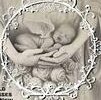Newborns are little and fragile, so clothes should be comfortable and easy to dress. Look for clothes that fasten at the front, with wide necks or snap closures, and ties or sleeves that can be rolled up for easy dressing. Clothing should be made from natural fabrics that feel gentle against newborn skin and wash well. Avoid synthetic fabrics, which can be rough on the baby’s sensitive skin and can cause allergic reactions.
Buy only what you need
Babies grow quickly, and they often outgrow their clothes before the next size is needed. This creates a cycle of buying and discarding outfits that can be expensive and wasteful, especially for families who may be financially strapped after having a child.
Embrace second-hand: Thrift stores and online marketplaces sell gently used baby clothes, which can be a great way to save money and reduce the amount of clothing that ends up in landfills. However, if you choose to shop second-hand, be sure to only purchase high-quality items that will hold up after washing, and look for durable, organic fabrics.
Focus on basics: Start with a basic wardrobe of simple cotton bodysuits (size 0-3 months) and onesies (2-3) that can be layered with tees (5-6), reversible jackets (3-4) and dual-use bibs (4-6) to mix and match. Avoid clothing with intricate embroidery or patterns, as these can be too scratchy for the baby and may not stand up to repeated wear.
Opt for neutral and organic colors: Many brands carry gender-neutral and organic clothing options, which are more affordable than more traditionally designed pieces. Also, opt for neutral-colored clothes that are less likely to be stained by food or diaper accidents. Avoid pink and blue clothes, as these are associated with the sex of a baby and can lead to biased parenting decisions.
Consider the climate: Depending on where you live, it’s important to think about cold weather gear for your baby. A warm coat or sweater is a must, and snowsuits can be an excellent choice for babies who spend time outdoors in the winter.
Protect your baby’s skin: A soft skull cap helps keep the heat in, while thin mittens can help prevent scratching and chaffing. Leg warmers are a good choice, too, as they can be slipped over footies and pants to help babies stay warm without adding too much bulk.
New parents have a lot on their plates, and shopping for newborn clothes can be an additional burden. However, it’s important to remember that babies grow fast, and adorable clothing can pile up in storage boxes before they are worn. In addition, the chemicals found in water resistant and flame retardant clothing can be harmful to a baby’s developing skin. Dr Bell recommends using only non-toxic and organic clothing when shopping for a baby. This is the best way to ensure that your baby’s clothes are safe and sustainable for their first years of life.
